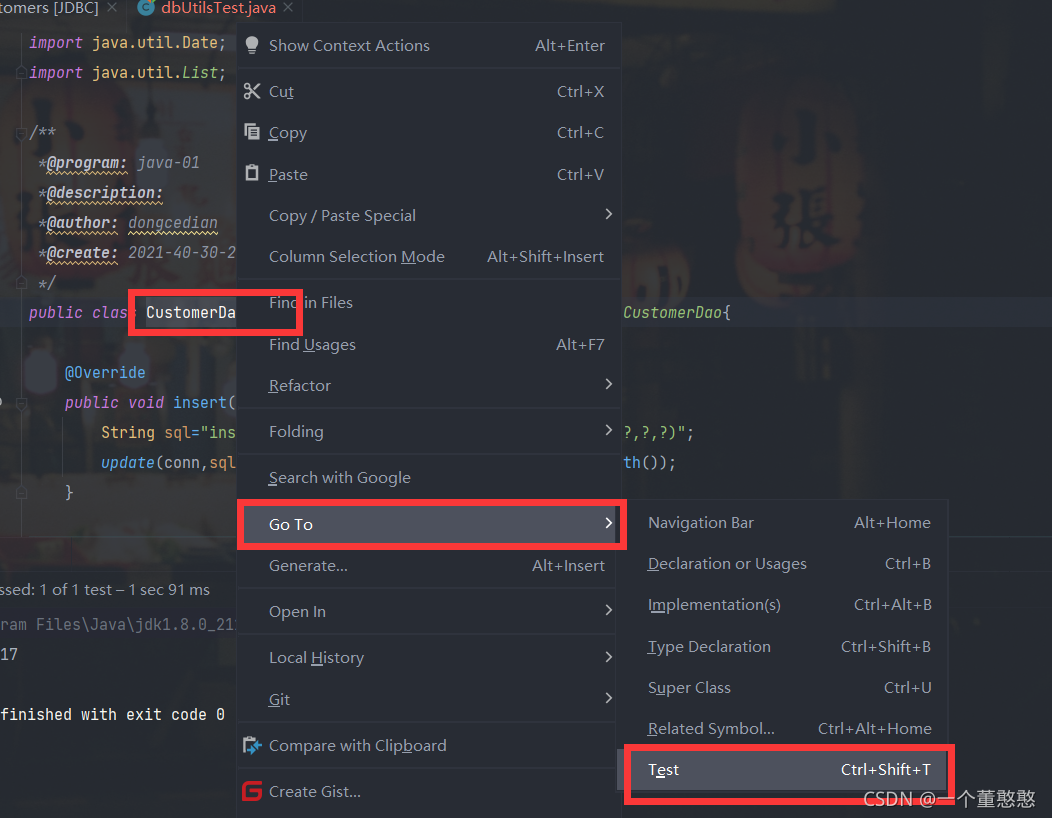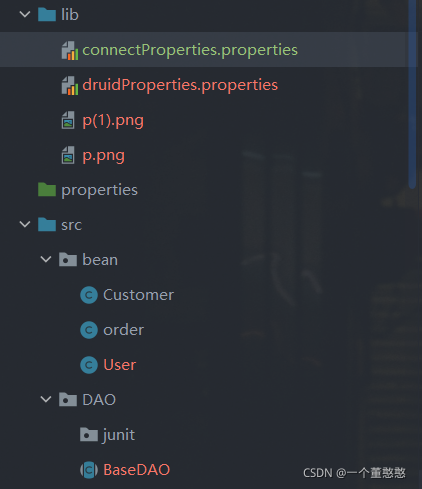JDBC使用模板
- 1、前言
- 2、主要的包
- 2.1、bean包
- 2.2、DAO包
- 2.3、JDBCUtil包
- 3、dbUtils jar包
1、前言
学习JDBC是一个技术迭代的过程,从无到有,现在已经集成好了轮子只要拿来使用就可以了,所以这个模板用来在开发中直接复制粘贴就可。
2、主要的包
bean 包:用于将数据库中的数据对应成类
DAO包:BaseDAO存放的是增删改的基本操作,剩下两个是对应到类的接口和接口实现类,juint用来测试接口实现类中的方法是否有错误
JDBCUtil:用于提供数据库连接和关闭数据可连接的操作

2.1、bean包
以Customer举例:属性、构造器、get、set方法和toString
//ORM(object relational mapping)编程思想:一个数据表对应一个java类
public class Customer {
private int id;
private String name;
private String email;
private Date birth;
public Customer() {
}
public Customer(int id, String name, String email, Date birth) {
this.id = id;
this.name = name;
this.email = email;
this.birth = birth;
}
public int getId() {
return id;
}
public void setId(int id) {
this.id = id;
}
public String getName() {
return name;
}
public void setName(String name) {
this.name = name;
}
public String getEmail() {
return email;
}
public void setEmail(String email) {
this.email = email;
}
public Date getBirth() {
return birth;
}
public void setBirth(Date birth) {
this.birth = birth;
}
@Override
public String toString() {
return "Customer{" +
"id=" + id +
", name='" + name + '\'' +
", email='" + email + '\'' +
", birth=" + birth +
'}';
}
}
2.2、DAO包
- BaseDAO
自己写的(不太健壮)
public abstract class BaseDAO<T> {
private Class<T> clazz=null;
{
Type genericSuperclass = this.getClass().getGenericSuperclass();
ParameterizedType parameterizedType = (ParameterizedType) genericSuperclass;
Type[] actualTypeArguments = parameterizedType.getActualTypeArguments();
clazz= (Class<T>) actualTypeArguments[0];
}
//通用增删改操作
public static void update(Connection conn, String sql, Object ...args){//占位符的个数,取决于可变形参数组的长度
PreparedStatement ps = null;
try {
ps = conn.prepareStatement(sql);
for(int i=0;i<args.length;++i){
ps.setObject(i+1,args[i]);
}
ps.execute();
} catch (Exception e) {
e.printStackTrace();
} finally {
try {
conn.setAutoCommit(true);
} catch (SQLException e) {
e.printStackTrace();
}
try {
ps.close();
} catch (SQLException e) {
e.printStackTrace();
} finally {
}
}
}
//获得一个查询的结果
public T getInstance(Connection conn, String sql, Object ...args){
PreparedStatement ps=null;
ResultSet resultSet=null;
try{
conn = JDBCUtils.getConnection();
ps = conn.prepareStatement(sql);
for(int i=0;i<args.length;++i){
ps.setObject(i+1,args[i]);
}
resultSet = ps.executeQuery();
ResultSetMetaData metaData = resultSet.getMetaData();
int columnCount = metaData.getColumnCount();
ArrayList<T> list = new ArrayList<>();
if(resultSet.next()){
T t = clazz.newInstance();
for(int i=0;i<columnCount;++i){
Object columnValue = resultSet.getObject(i + 1);
String columnLabel = metaData.getColumnLabel(i+1);
Field field = clazz.getDeclaredField(columnLabel);
field.setAccessible(true);
field.set(t,columnValue);
}
return t;
}
}catch (Exception e){
System.out.println(e.getMessage());
}finally {
try {
ps.close();
} catch (SQLException e) {
e.printStackTrace();
}
try {
resultSet.close();
} catch (SQLException e) {
e.printStackTrace();
}
}
return null;
}
//查找的通用函数
public List<T> getForList(Connection conn, String sql, Object ...args){
PreparedStatement ps=null;
ResultSet resultSet=null;
try{
conn = JDBCUtils.getConnection();
ps = conn.prepareStatement(sql);
for(int i=0;i<args.length;++i){
ps.setObject(i+1,args[i]);
}
resultSet = ps.executeQuery();
ResultSetMetaData metaData = resultSet.getMetaData();
int columnCount = metaData.getColumnCount();
ArrayList<T> list = new ArrayList<>();
while(resultSet.next()){
T t = clazz.newInstance();
for(int i=0;i<columnCount;++i){
Object columnValue = resultSet.getObject(i + 1);
String columnLabel = metaData.getColumnLabel(i+1);
Field field = clazz.getDeclaredField(columnLabel);
field.setAccessible(true);
field.set(t,columnValue);
}
list.add(t);
}
return list;
}catch (Exception e){
System.out.println(e.getMessage());
}finally {
try {
ps.close();
} catch (SQLException e) {
e.printStackTrace();
}
try {
resultSet.close();
} catch (SQLException e) {
e.printStackTrace();
}
}
return null;
}
//查询特殊值的函数
public <E> E getValue(Connection conn,String sql,Object ...args){
PreparedStatement ps = null;
ResultSet resultSet = null;
try {
ps = conn.prepareStatement(sql);
for(int i=0;i<args.length;++i){
ps.setObject(i+1,args[i]);
}
resultSet = ps.executeQuery();
if(resultSet.next()){
return (E) resultSet.getObject(1);
}
} catch (SQLException e) {
e.printStackTrace();
} finally {
JDBCUtils.closeResource(conn,ps,resultSet);
}
return null;
}
}
DbUtils包,Apache公司提供的包,很健壮,推荐使用
public abstract class BaseDAO<T> {
private Class<T> clazz=null;
{
Type genericSuperclass = this.getClass().getGenericSuperclass();
ParameterizedType parameterizedType = (ParameterizedType) genericSuperclass;
Type[] actualTypeArguments = parameterizedType.getActualTypeArguments();
clazz= (Class<T>) actualTypeArguments[0];
}
//通用增删改操作
public static void update(Connection conn, String sql, Object ...args){//占位符的个数,取决于可变形参数组的长度
try {
QueryRunner runner = new QueryRunner();
int update = runner.update(conn, sql, args);
System.out.println("更改了"+update+"条数据");
} catch (SQLException e) {
e.printStackTrace();
} finally {
JDBCUtils.closeResource(conn);
}
}
//获得一个查询的结果
public T getInstance(Connection conn, String sql, Object ...args){
try {
QueryRunner runner = new QueryRunner();
BeanHandler<T> handler = new BeanHandler<T>(clazz);
return runner.query(conn, sql, handler,args);
} catch (SQLException e) {
e.printStackTrace();
} finally {
JDBCUtils.closeResource(conn);
}
return null;
}
//查找的通用函数
public List<T> getForList(Connection conn, String sql, Object ...args){
try {
QueryRunner runner = new QueryRunner();
BeanListHandler<T> handler = new BeanListHandler<>(clazz);
return runner.query(conn, sql, handler,args);
} catch (SQLException e) {
e.printStackTrace();
} finally {
JDBCUtils.closeResource(conn);
}
return null;
}
//查询特殊值的函数
public <E> E getValue(Connection conn,String sql,Object ...args){
try {
QueryRunner runner = new QueryRunner();
ScalarHandler handler = new ScalarHandler();
E query = (E)runner.query(conn, sql, handler);
return query;
} catch (SQLException e) {
e.printStackTrace();
} finally {
JDBCUtils.closeResource(conn);
}
return null;
}
}
- CustomerDao:作为一个例子,实际开发中要根据需求进行改写
public interface CustomerDao {
//将Customer对象添加到数据库中
void insert(Connection conn, Customer cust);
//根据id删除表内记录
void deleteById(Connection conn,int id);
//将指定id对象修改成指定对象
void update(Connection conn,Customer cust);
//针对指定Id查询对应的Customer对象
Customer getCustomerById(Connection conn,int id);
//查询表中的所有记录构成的集合
List<Customer> getAll(Connection conn);
//返回数据表中数据数
long getCount(Connection conn);
//
Date getMaxBirth(Connection conn);
}
- CustomerDaoImpl:接口实现类
public class CustomerDaoImpl extends BaseDAO<Customer> implements CustomerDao{
@Override
public void insert(Connection conn, Customer cust) {
String sql="insert into customers(name,email,birth)values(?,?,?)";
update(conn,sql,cust.getName(),cust.getEmail(),cust.getBirth());
}
@Override
public void deleteById(Connection conn, int id) {
String sql="delete from customers where id=?";
update(conn,sql,id);
}
@Override
public void update(Connection conn, Customer cust) {
String sql="update customers set name=?,email=?,birth=? where id=?";
update(conn,sql,cust.getName(),cust.getEmail(),cust.getBirth(),cust.getId());
}
@Override
public Customer getCustomerById(Connection conn, int id) {
String sql="select id,name,email,birth from customers where id=?";
Customer instance = getInstance(conn, sql, id);
return instance;
}
@Override
public List<Customer> getAll(Connection conn) {
String sql="select id,name,email,birth from customers";
List<Customer> list = getForList(conn, sql);
return list;
}
@Override
public long getCount(Connection conn) {
String sql="select count(*) from customers";
long value = (long)getValue(conn, sql);
return value;
}
@Override
public Date getMaxBirth(Connection conn) {
String sql="select max(birth) from customers";
return getValue(conn, sql);
}
}
- Junit包:进行验证
创建方法如下,选择好需要验证的类,如下

public class CustomerDaoImplTest {
private CustomerDaoImpl dao=new CustomerDaoImpl();
@Test
public void testinsert() {
Connection conn = null;
try {
conn = JDBCUtils.getConnection();
SimpleDateFormat sdf = new SimpleDateFormat("yyyy-MM-dd hh:mm:ss");
Date parse = sdf.parse("2000-09-16 18:56:10");
Customer customer = new Customer(1, "董策典", "1355766867@qq.com", new java.sql.Date(parse.getTime()));
dao.insert(conn,customer);
System.out.println("添加成功");
} catch (Exception e) {
e.printStackTrace();
} finally {
try {
conn.close();
} catch (SQLException e) {
e.printStackTrace();
}
}
}
@Test
public void deleteById() {
Connection conn = null;
try {
conn = JDBCUtils.getConnection();
dao.deleteById(conn,23);
} catch (Exception e) {
e.printStackTrace();
} finally {
JDBCUtils.closeResource(conn);
}
}
@Test
public void update() {
Connection conn = null;
try {
conn = JDBCUtils.getConnectionDruid();
SimpleDateFormat sdf = new SimpleDateFormat("yyyy-MM-dd hh:mm:ss");
Date parse = sdf.parse("2001-06-13 5:13:50");
Customer customer = new Customer(27, "李憨批", "250@qq.com", new java.sql.Date(parse.getTime()));
dao.update(conn,customer);
} catch (SQLException e) {
e.printStackTrace();
} catch (ParseException e) {
e.printStackTrace();
} finally {
JDBCUtils.closeResource(conn);
}
}
@Test
public void getCustomerById() {
Connection conn = null;
try {
conn = JDBCUtils.getConnection();
Customer customer = dao.getCustomerById(conn, 27);
System.out.println(customer);
} catch (Exception e) {
e.printStackTrace();
} finally {
JDBCUtils.closeResource(conn);
}
}
@Test
public void getAll() {
Connection conn = null;
try {
conn = JDBCUtils.getConnectionDruid();
for (Customer customer : dao.getAll(conn)) {
System.out.println(customer);
}
} catch (SQLException e) {
e.printStackTrace();
} finally {
JDBCUtils.closeResource(conn);
}
}
@Test
public void getCountTest() {
Connection conn = null;
try {
conn = JDBCUtils.getConnectionDruid();
long count = dao.getCount(conn);
System.out.println(count);
} catch (SQLException e) {
e.printStackTrace();
} finally {
JDBCUtils.closeResource(conn);
}
}
@Test
public void getMaxBirth() {
Connection conn = null;
try {
conn = JDBCUtils.getConnection();
Date maxBirth = dao.getMaxBirth(conn);
System.out.println(maxBirth);
} catch (Exception e) {
e.printStackTrace();
} finally {
JDBCUtils.closeResource(conn);
}
}
}
2.3、JDBCUtil包
public class JDBCUtils {
/*
*@description: 获取数据库连接
*@author: dongcedian
*@date:2021/9/27
*/
public static Connection getConnection() throws Exception {
InputStream resource = ClassLoader.getSystemClassLoader().getResourceAsStream("connectProperties.properties");
Properties properties = new Properties();
properties.load(resource);
String user = properties.getProperty("user");
String password = properties.getProperty("password");
String url = properties.getProperty("url");
String driver = properties.getProperty("driver");
Class.forName(driver);
Connection conn = DriverManager.getConnection(url, user, password);
return conn;
}
/*
*@description: 关闭操作
*@author: dongcedian
*@date:2021/9/27
*/
public static void closeResource(Connection conn){
DbUtils.closeQuietly(conn);
}
public static void closeResource(Connection conn, Statement pre){
DbUtils.closeQuietly(conn);
DbUtils.closeQuietly(pre);
}
public static void closeResource(Connection conn, Statement pre, ResultSet res){
DbUtils.closeQuietly(conn);
DbUtils.closeQuietly(pre);
DbUtils.closeQuietly(res);
}
//使用Druid获取一个数据库连接池
private static DataSource source;
static {
try {
Properties pros = new Properties();
InputStream is = ClassLoader.getSystemClassLoader().getResourceAsStream("druidProperties.properties");
pros.load(is);
source = DruidDataSourceFactory.createDataSource(pros);
} catch (Exception e) {
e.printStackTrace();
}
}
public static Connection getConnectionDruid() throws SQLException {
return source.getConnection();
}
}
其中涉及到两个配置文件的位置及内容

- connectProperties.properties
user=root
password=root
url=jdbc:mysql://localhost:3306/test1?rewriteBatchedStatements=true
driver=com.mysql.cj.jdbc.Driver
- druidProperties.properties
url=jdbc:mysql://localhost:3306/test1
username=root
password=root
driverClassName=com.mysql.cj.jdbc.Driver
initialSize=10
maxActive=10
3、dbUtils jar包
链接:https://pan.baidu.com/s/1GJzgUNAuiu9Pk0e_ldmK4g
提取码:hhxd
如果想了解如何迭代的请看我的博客
JDBC上
JDBC下